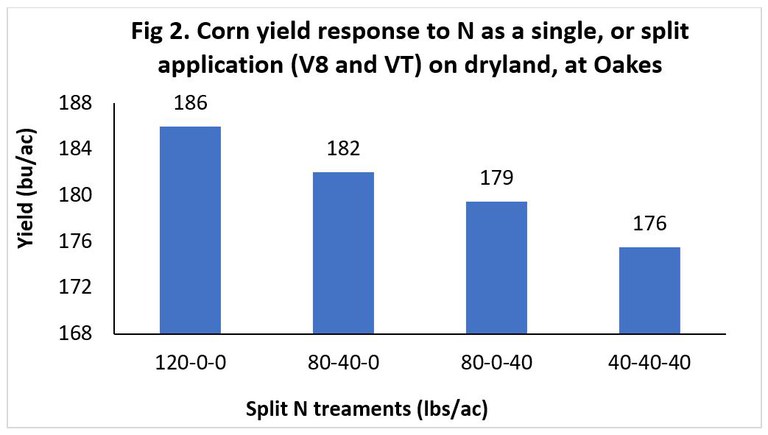Yield Impact of N Applied to Corn at Tasseling
Objectives
- Verify whether N fertilization at tasseling (VT) would improve corn yields in North Dakota
- Assess whether yield response to split N will differ between dryland and irrigated corn
- Determine if improved yields would justify the cost of late N application?
Methods
Two trials were conducted on dryland and under irrigation at Oakes, and one under irrigation at Carrington, ND. 14 fertilizer treatments were applied. The first six N treatments were pre-plant N at 0, 40, 80, 120, 160, and 200 lbs N/ac. Eight other treatments were splits that either received 0 lbs, 40 lbs, or 80 lbs N as starter, plus 40 lbs N top-dress at either V8 or at tasseling (VT).
Results
- Yields responded positively to N at Oakes. Yields did not respond to N at Carrington; thus, the split N results were not important.
- Maximum yield at Oakes was 259 bushels at 200 lbs N under irrigation, and 195 bushels at 200 lbs N on dryland. Yields were not significantly different between 200 and 120 lbs N either under irrigation (227 bushels) or on dryland (186 bushels).
- Even though split application of N at a total rate of 120 lbs N did not result in statistical yield differences the response to split N application was different between the irrigated and dryland sites.
- Under irrigation, split application of 120 lbs N produced higher yields than a single application at planting. The split N treatment that received 40 lbs as starter, 40 lbs at V8, and 40 lbs at VT (40-40-40) produced the best yield at 120 lbs N total (Fig 1). It is probable that when the fertilizer was split, it prevented some N loss due to leaching. The soil is well drained; frequent irrigation would have probably moved some of the N below the reach of the roots (leaching).

- On dryland, application of all 120 lbs N at planting produced the highest yield when compared to split application treatments (Fig 2). Because the dryland field had received beddings in fall the previous year, some of the N may have been tied up, and as a result, much N needed to be availability early and throughout the growing season.

Conclusion
In environments of high rainfall or where irrigation practiced, split application of N would be recommended to minimize N loss to leaching. Due to lack of significant yield differences between the single and split N applications it would have been uneconomical to have applied N later in the growing season. Nonetheless, split-application of N with most of the N applied at planting, and the rest around V6 to V8 remains a safe strategy to minimize N loss and enhance N fertilizer use efficiency in corn.
We gratefully acknowledge funding from the North Dakota Corn Council in support of this research.
Jasper Teboh, Ph.D.
Jasper.Teboh@ndsu.edu
Soil Scientist


